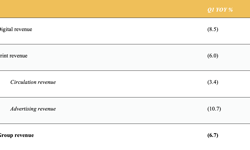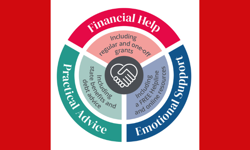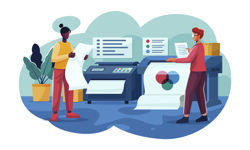We have so many different types of connections these days. Work friends. Neighbours. Family. Old childhood friends. Old childhood Facebook friends. Old childhood enemies who are now inexplicably our Facebook friends.
While our virtual social groups are growing, participants in a recent study conducted at Cornell University listed an average of only 2.03 close friends. Sociologist Matthew Brashears defines these relationships as “…your real confidants, your go-to people if you need something”.
Think of it: would you rely on the vast majority of your own social media circles to, say, help you move, drop you off at the airport, pick you up when relationships end or when professional redundancies begin?
Online and off, you expect different things from your different personal connections — and you interact with them accordingly. So why, as a circulation marketing professional, would you continue to use a one-size-fits-all social media solution to speak to and grow your audience?
Isolate Which Social Network Best Fits Your Title… and Your Marketing Goals
As the owner of an advertising agency, I find myself on a fair number of sales calls. It’s often a mixture of tactfully proving the firm’s expertise and immediate value in our corner of the marketing world — while peppering in conversational details that communicate we’re human… sensible… and trustworthy.
I recently had two back-to-back conversations that were worlds apart. The first had me discussing bucolic summer homes on the East Coast of America. The other turned, oddly, towards how to best hunt turkey with a bow and arrow. (Hint: Don’t start off your birdcalls too loudly, evidently. Instead build in intensity and volume over 20 minutes.)
The point is that while my goal was the same on both calls — wanting to build awareness and ultimately revenue — the delivery was day and night.
In this vein, here are a few case studies, tips, and warnings of what is (and isn’t) working for US publishers from one social network to the next…
1. Facebook.
According to Facebook internal data, the average media site integrated with a Like button sees a 300% increase in referral traffic. Add to the equation the fact that Facebook apps allow users to share which videos they’ve watched, what articles they read, or how they feel about a certain song, and it’s no wonder that publishers are clamouring to increase their reach using the planet’s leading social utility.
Spin magazine, like many titles, is working hard to find its way in the digital world. Having cut its frequency in half and emerged as a bi-monthly earlier this year, their print edition now focuses on longer-term trends in the industry, extended editorials and interviews — relegating album reviews to their website and Twitter.
The magazine now counts among its 500,000 total circulation a slightly more mature audience of fans who lived through the Manchester / “Madchester” music scene and grunge years of the late 80s and early 90s.
After a previous success celebrating the 25th anniversary of Prince’s Purple Rain, Spin released a tribute album to Nirvana’s Nevermind in August of 2011, to mark 20 years since that record’s release. Using a fan gate to act as a firewall, visitors had to provide their email addresses before being able to download the free 13-track cover album (featuring artists including The Vaselines and Meat Puppets).
As of press time, the magazine now counts nearly 170,000 Facebook likes and has a new, free email list it can prospect to — by touting upcoming issues, late-breaking band breakups, and other free mp3s and content targeted to this name group.
Spin’s online successes are laudable, but pale in comparison with the niche music magazine, Revolver. With less than one-third the print audience of Spin, Revolver transformed from a general audience music magazine into one focusing on heavy metal and hard rock. Yet today they have more likes than Spin.
How? Rather than offering a free download, they leveraged their annual Golden Gods music awards to stream the event on Facebook using urgency to quickly build their follower base.
When evaluating your options — from sweepstakes to exclusive editorial content and downloads — review your editorial and events calendar and see if there’s any missed-opportunities you can be using to build your prospecting list or likes. (According to the analytics firm Hitwise, each like yields 20 unique visitors to your title’s site per year. That’s twenty more bites at the apple when trying to convert traffic into paid or verified subscribers.)
But let’s not get ahead of ourselves just yet. If you haven’t already done so, add Insights to your brand’s page to capture available visitor demographic data. This tracking code will allow your team to start gathering the history needed to help maximise your next campaign.
2. LinkedIn.
Facebook and Twitter are logical forums for consumer titles. But when it comes to trade publications or magazines focused on the world of business, LinkedIn has proven to be fertile ground. The circulation department at the Massachusetts Institute of Technology’s Sloan Management Review plays long ball when it comes to building their audience.
Rather than exclusively promoting their own articles, the team positions MIT Sloan Management Review as the gatekeeper on innovation in the workplace — often by posting links to their direct competitors, such as Harvard Business Review and Forbes.
This leads to more eyeballs on their updates. More clicks. Plus more authority as followers don’t feel they are simply being marketed to. And these factors are the exact things Google’s recent Penguin search algorithm update takes into mind when ranking brands. (This effort is Google’s attempt to keep “spammy” websites — which artificially keyword stuff or use black hat link building techniques — from showing up in search results.) For MIT Sloan Management Review that’s smart business.
3. Pinterest.
While digital communities can be used to increase awareness of print publications, sometimes the old vanguard can also impact the fortunes of photo social sites. In part due to Time magazine’s inclusion of Pinterest on its “50 Best Websites of 2011” list late last summer, the photo-sharing destination began its meteoric rise from tens of thousands of unique visitors to more than 20 million.
In this same time period, according to Compete.com, older social destinations like MySpace shed nearly 25% of their unique traffic.
It’s not simply the number of people on Pinterest that is grabbing marketers’ attention. Just one month after Pinterest broke into the top 10 social networks stratum, it drove more referral ecommerce traffic than LinkedIn, YouTube, and Google+. Now a joint study by comScore, Shop.org, and The Partnering Group reveals users are engaging with retailers more than with Facebook and Twitter.
How can you take advantage of the power and reach of Pinterest? You can’t just wish your content to “go viral” and be shared or repinned. Use these three simple rules of thumb to help make your images stand out:
* Relevance — As a publisher you have unique access to compelling content. From photos to contributor quotes to infographics, use this opportunity to present a “best of” glimpse at your title’s unique take on the world.
* Dimension — Images that are 300 pixels wide or smaller cannot be pinned. The maximum width is 554 pixels to avoid having them be resized. While there is no vertical limit, it’s best to keep the height to 5,000 pixels. This way viewers don’t have to scroll and your pinned item has more immediate visual impact.
What if you don’t have the art resources or budget to manipulate images? Pixir.com is a free browser-based editing solution you can use to add text, filters, and other layers to existing editorial photos.
Are you looking to quickly repurpose content from your other social presences? Your YouTube videos can also be pinned. (Since YouTube is now owned by Google, rumour has it a healthy YouTube channel and presence on Google+ will go a long way to help your business optimise its search engine rankings since the April Penguin updates.)
* Ranking — Finally, be sure to name your files uses compelling keywords and phrases. “Worlds-Most-Delicious-Guilt-Free-Dessert.jpg” is bound to place better than a random collection of numbers.
If you pin directly from your site or blog, follow SEO best practices by adding a title, description and “alt” text. Google’s robots will then crawl your pins — and this extra link-juice will help raise your rankings on organic search.
The ROI on Social Media and SEO
When prioritising and implementing your remaining marketing plans for the year, it can be difficult to compare the value of likes and repins to the money-in-the-bank numbers of subscribers acquired or retained through direct mail, email or display network advertising.
Business success for publishers on the web today begins with a critical shift in mindset. The proper use of social media isn’t just a new way to connect to a wider audience your title can serve, it’s also necessary to stay on Google’s good side.
I’ve referenced updates to Google’s search algorithms twice already in this article. For good reason. With online retailers experiencing dips of up to 7% or more in revenue due to falls in page rank, marketers are now seeing direct links between gaps in their social media activities and their bottom line. That’s because to Google your site’s authority is now connected to what consumers are saying about you on networks like Facebook, LinkedIn and Pinterest.
Quality social content is a key factor behind targeted traffic volume and consumer trust. The secret is applying this knowledge to your editorial content in order to increase and sustain your publication in the age of digital publishing. Just like making valuable, lasting connections in the real world, success is all about how you present yourself.










